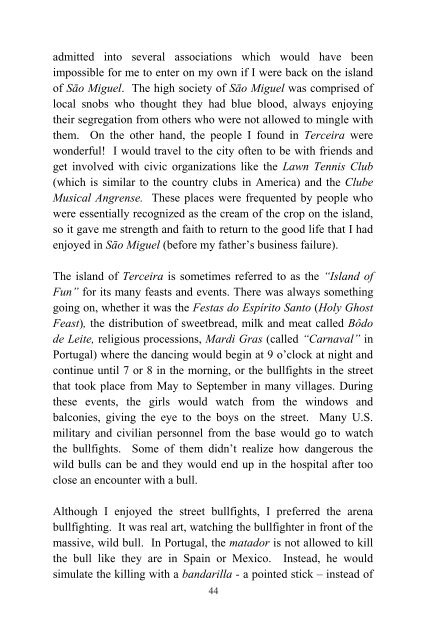My Memoirs - Citizen of the World
My Memoirs - Citizen of the World
My Memoirs - Citizen of the World
Create successful ePaper yourself
Turn your PDF publications into a flip-book with our unique Google optimized e-Paper software.
admitted into several associations which would have been<br />
impossible for me to enter on my own if I were back on <strong>the</strong> island<br />
<strong>of</strong> Sāo Miguel. The high society <strong>of</strong> Sāo Miguel was comprised <strong>of</strong><br />
local snobs who thought <strong>the</strong>y had blue blood, always enjoying<br />
<strong>the</strong>ir segregation from o<strong>the</strong>rs who were not allowed to mingle with<br />
<strong>the</strong>m. On <strong>the</strong> o<strong>the</strong>r hand, <strong>the</strong> people I found in Terceira were<br />
wonderful! I would travel to <strong>the</strong> city <strong>of</strong>ten to be with friends and<br />
get involved with civic organizations like <strong>the</strong> Lawn Tennis Club<br />
(which is similar to <strong>the</strong> country clubs in America) and <strong>the</strong> Clube<br />
Musical Angrense. These places were frequented by people who<br />
were essentially recognized as <strong>the</strong> cream <strong>of</strong> <strong>the</strong> crop on <strong>the</strong> island,<br />
so it gave me strength and faith to return to <strong>the</strong> good life that I had<br />
enjoyed in Sāo Miguel (before my fa<strong>the</strong>r’s business failure).<br />
The island <strong>of</strong> Terceira is sometimes referred to as <strong>the</strong> “Island <strong>of</strong><br />
Fun” for its many feasts and events. There was always something<br />
going on, whe<strong>the</strong>r it was <strong>the</strong> Festas do Espírito Santo (Holy Ghost<br />
Feast), <strong>the</strong> distribution <strong>of</strong> sweetbread, milk and meat called Bôdo<br />
de Leite, religious processions, Mardi Gras (called “Carnaval” in<br />
Portugal) where <strong>the</strong> dancing would begin at 9 o’clock at night and<br />
continue until 7 or 8 in <strong>the</strong> morning, or <strong>the</strong> bullfights in <strong>the</strong> street<br />
that took place from May to September in many villages. During<br />
<strong>the</strong>se events, <strong>the</strong> girls would watch from <strong>the</strong> windows and<br />
balconies, giving <strong>the</strong> eye to <strong>the</strong> boys on <strong>the</strong> street. Many U.S.<br />
military and civilian personnel from <strong>the</strong> base would go to watch<br />
<strong>the</strong> bullfights. Some <strong>of</strong> <strong>the</strong>m didn’t realize how dangerous <strong>the</strong><br />
wild bulls can be and <strong>the</strong>y would end up in <strong>the</strong> hospital after too<br />
close an encounter with a bull.<br />
Although I enjoyed <strong>the</strong> street bullfights, I preferred <strong>the</strong> arena<br />
bullfighting. It was real art, watching <strong>the</strong> bullfighter in front <strong>of</strong> <strong>the</strong><br />
massive, wild bull. In Portugal, <strong>the</strong> matador is not allowed to kill<br />
<strong>the</strong> bull like <strong>the</strong>y are in Spain or Mexico. Instead, he would<br />
simulate <strong>the</strong> killing with a bandarilla - a pointed stick – instead <strong>of</strong><br />
44


